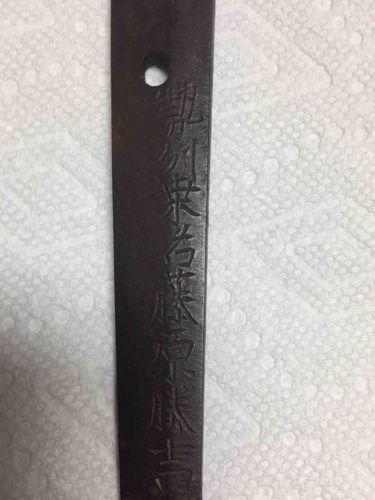
Japanese Sword Tang (Nakago)
The item depicted is a sword tang, specifically known as a 'nakago' in Japanese sword terminology. It is a long, narrow, and flat piece of dark metal, likely steel, which forms the unsharpened part of a Japanese sword blade that fits into the handle (tsuka). The metal appears to be a rich, dark brown or nearly black color, consistent with the patina that develops on aged steel, particularly in an area not meant to be polished or exposed. A prominent feature is a circular hole, known as a 'mekugi-ana', drilled through the tang, which is used to secure the blade to the hilt with a bamboo peg (mekugi). Below this hole, a series of etched or carved characters, possibly 'kanji', are visible, running vertically down the tang. These characters constitute the 'mei' or signature of the swordsmith or a descriptive inscription. The marks appear to be hand-engraved rather than stamped, indicating traditional craftsmanship. The clarity of the characters suggests a level of skill in their creation, though some wear or corrosion might slightly obscure the finer details. The surface of the tang shows some minor irregularities and possible pitting, typical for an aged metal object that has been handled and perhaps exposed to varying atmospheric conditions, contributing to its authentic antique appearance. The edges of the tang appear somewhat softened, consistent with age and possibly some minor superficial corrosion or patina build-up. There are no obvious signs of significant damage like bends or breaks, suggesting the structural integrity of the tang is largely intact. The workmanship involved in shaping the tang and engraving the mei is a critical indicator of its quality and historical provenance.
AI-Generated Appraisal Disclaimer
Estimated Value
$300 - $800
Basic Information
Category
Blade Component
Appraised On
December 20, 2025
Estimated Value
$300 - $800
Item Description
The item depicted is a sword tang, specifically known as a 'nakago' in Japanese sword terminology. It is a long, narrow, and flat piece of dark metal, likely steel, which forms the unsharpened part of a Japanese sword blade that fits into the handle (tsuka). The metal appears to be a rich, dark brown or nearly black color, consistent with the patina that develops on aged steel, particularly in an area not meant to be polished or exposed. A prominent feature is a circular hole, known as a 'mekugi-ana', drilled through the tang, which is used to secure the blade to the hilt with a bamboo peg (mekugi). Below this hole, a series of etched or carved characters, possibly 'kanji', are visible, running vertically down the tang. These characters constitute the 'mei' or signature of the swordsmith or a descriptive inscription. The marks appear to be hand-engraved rather than stamped, indicating traditional craftsmanship. The clarity of the characters suggests a level of skill in their creation, though some wear or corrosion might slightly obscure the finer details. The surface of the tang shows some minor irregularities and possible pitting, typical for an aged metal object that has been handled and perhaps exposed to varying atmospheric conditions, contributing to its authentic antique appearance. The edges of the tang appear somewhat softened, consistent with age and possibly some minor superficial corrosion or patina build-up. There are no obvious signs of significant damage like bends or breaks, suggesting the structural integrity of the tang is largely intact. The workmanship involved in shaping the tang and engraving the mei is a critical indicator of its quality and historical provenance.
Related Tags
Get Your Items Appraised
Instant estimates of your treasures with AI-powered instant appraisals